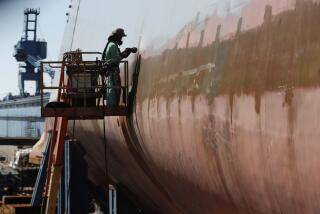Missile Program Criticized Despite 1st Successful Test
- Share via
WASHINGTON — The Army’s theater missile-defense system, despite a first successful flight test last month, still faces serious technical problems because of its reliance on parts that may be faulty, according to a new government report.
The General Accounting Office report says the Pentagon took important strides last year in reorganizing the $3.8-billion program, a forerunner to a larger program aimed at shielding the entire nation from a missile attack.
Yet the interceptor missiles it would use “remain a concern” because most components were produced before the reorganization, when quality control was inadequate, the report asserts.
The Theater High Altitude Area Defense, or THAAD, program also is intended to protect U.S. troops and heavy equipment in such international hot spots as the Korean peninsula. It has been a focus of a national debate over the feasibility of a defensive system in which missiles knock down other missiles while both are traveling at extremely high speeds.
Last month, after six failed tests, advocates claimed a breakthrough in this Star Wars-like technology when a THAAD interceptor collided with a 20-foot missile high above the New Mexico desert.
But the new report says Lockheed Martin, the contractor, has not taken steps to guarantee that the key parts will function in future tests. Of the major components, it says, only the seeker--the part used to locate and track the target missile--was built after 1996, when the quality controls were improved.
After the fifth failed test, in May 1998, the contractor reevaluated or retested the parts, according to the report. But it contended that this was not a sufficient substitute for building parts with sufficient quality controls.
And it quoted the Pentagon’s director for Operational Test and Evaluation as saying that until new equipment is built, “there is no reason to expect any improvement in the THAAD interceptors’ performance.”
Before the successful test, the THAAD program had failed an earlier attempt, in March, because of a flawed component, the report asserted.
A spokeswoman for the Pentagon’s Ballistic Missile Defense Organization, which oversees the program, said officials are “very confident” that the parts are, in fact, up to quality standards.
John Pike, a defense analyst at the Federation of American Scientists, said quality standards are especially important in an anti-missile program, since one missed missile could cause huge numbers of casualties.
“Missile defense has uniquely high performance requirements,” he said, adding that the THAAD program has much to prove, given its record of past failures.
Republicans in Congress have been pushing the Clinton administration to deploy such a system, saying that it is urgently needed as countries such as North Korea and Iran develop missiles with ever-longer ranges.
The administration has been far less enthusiastic, worrying about the technical feasibility of such an expensive venture.
But in the last year, as the North Koreans and others have shown evidence of progress in their offensive programs, the administration has gradually grown more receptive.
More to Read
Sign up for Essential California
The most important California stories and recommendations in your inbox every morning.
You may occasionally receive promotional content from the Los Angeles Times.














